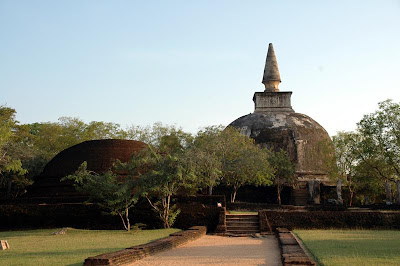
Parakramabahu's Palace must have been an imposing edifice, and the chronicles describe it as "seven stories high, furnished with a thousand chambers". Entering the palace from the south, you come to great hall (31 Metres long and 13 metres wide), which was probably an audience hall.
Across the way is the council chamber of Parakramabahu - embellished with lion portals, graceful pillars and a moonstone (a delicately carved stepping stone). The building is supported by powerful bas-relief elephants around the base. Each one is different from the next.
The structural techniques of this period were the same as those of the Anuradhapura period, but there was a greater use of lime mortar, which enabled the building of brick structures of dimensions never before
A little further on is the handsome royal bath, the Kumara Pokuna. This area was probably a part of the Royal Pleasure Garden of Parakramabahu. Water, which may have been perfumed, flowed into the bath from the sides, and the solid masses of stone ensured that even on the hottest day, the water was cool. Another feature of this garden was a shower bath, which was "like a cloud pouring forth rain by (reason of) the showers of water which flowed constantly from the pipes of the apparatus.






